Helping you stay safe on Britain's roads: DVSA's strategy for 2017 to 2022
Updated 13 April 2017
Applies to England, Scotland and Wales
Foreword

Andrew Jones, Road Safety Minister
Roads are vital for helping move people and goods around Great Britain, so road safety is a matter of national importance.
The government is committed to improving road safety. Road casualties devastate families and communities. Collisions also cost the economy an estimated £16.3 billion a year, and add pressure on the NHS and emergency services.
The Driver and Vehicle Standards Agency (DVSA) is working every day to help you stay safe on Great Britain’s roads. Its work affects everyone in the country - by making sure motorists have the knowledge and skills they need to drive safely, and freight can move efficiently on our roads.
We should be proud of Great Britain’s strong road safety record. In 2015, road casualties were the second lowest on record.
However, we need to plan for the future. As technology improves, vehicles will become more capable of driving themselves. We need to make sure driver training and testing keeps up, and the MOT adapts to be able to test vehicles that rely more and more on software.
So I’m delighted to introduce DVSA’s 5-year strategy, which sets out the work DVSA will do up to 2022 to build on our excellent national road safety record.
The strategy explains what DVSA will do to help all drivers through a lifetime of safe driving and help them keep their vehicles safe to drive. It also sets out the vital work that DVSA will do to protect you from unsafe drivers and vehicles.
I am grateful to the staff at DVSA for their commitment and dedication to helping you stay safe on Great Britain’s roads. We will need the help and support of driving instructors, garages, vehicle operators and all drivers to achieve the ambitious aims of DVSA’s strategy.
I look forward to seeing DVSA’s clear vision for the future become a reality - safer drivers, safer vehicles and safer journeys for all.
Andrew Jones
Road Safety Minister
1. Introduction
This strategy tells you what DVSA will do between 2017 and 2022 to help you stay safe on Britain’s roads.
The strategy is about improving:
- road safety
- user experience
- value for money
Watch a video that summarises our strategy, or read the video transcript[footnote 1].
Helping you stay safe on Britain’s roads: DVSA’s strategy for 2017 to 2022
2. The strategy: helping you stay safe on Britain’s roads
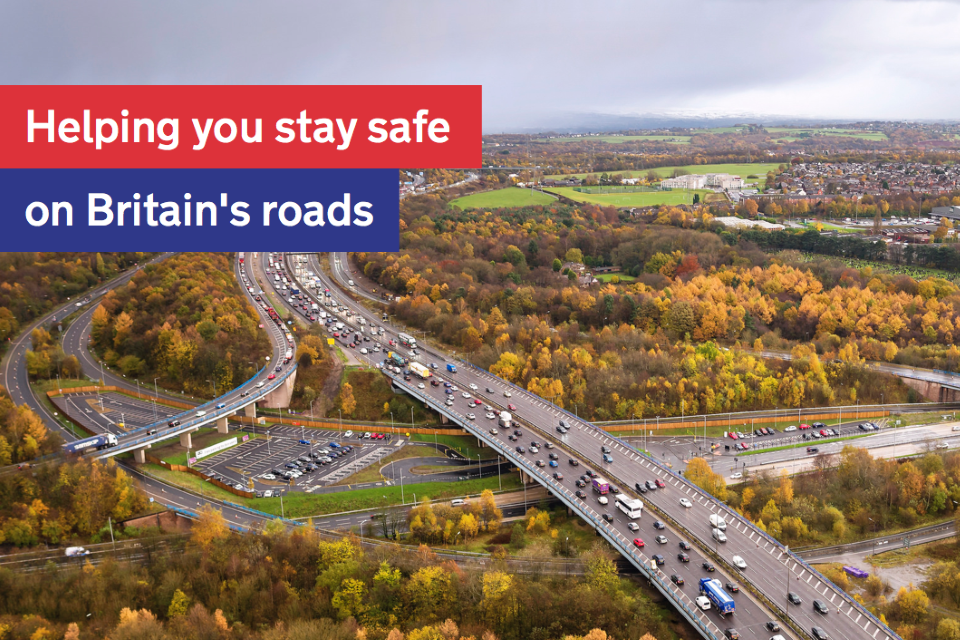
Helping you stay safe on Britain's roads
DVSA is an executive agency of the Department for Transport (DfT).
Our purpose at DVSA is to help you stay safe on Britain’s roads.
Our vision is for safer drivers, safer vehicles and safer journeys for all.
Our strategy is split into 3 themes:
- helping you through a lifetime of safe driving
- helping you keep your vehicle safe to drive
- protecting you from unsafe drivers and vehicles
By December 2017, we’ll create detailed plans for each of these 3 themes. The plans will include how we’ll measure our success in each area.
Our annual business plans will set out which parts of the strategy we’ll take forward each year.
2.1 Helping you through a lifetime of safe driving
We’ll make sure new drivers are better prepared for a lifetime of safe driving and have access to guidance, advice and training that helps to keep them safe. We’ll also do more to make sure driving tests are available at times and places which are more convenient for learner drivers.
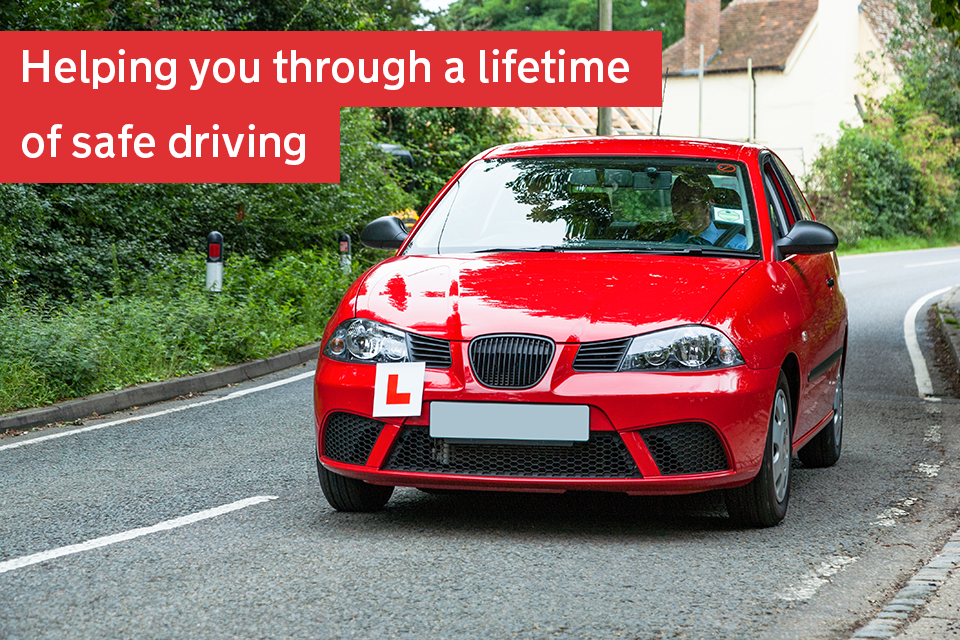
Helping you through a lifetime of safe driving
Better information and training for drivers
To better meet the needs of learner drivers, we’ll make sure:
- they have access to information that helps them choose the best instructor for their needs
- they have the skills, knowledge and experience they need to pass their driving test the first time
- instructors and trainers provide a high standard of training
To better meet the needs of all drivers, we’ll make sure:
- new drivers have guidance, information and support to keep them safe when they’re new to driving - for example, by sending personalised advice to them based on the faults they made during their driving test
- drivers know how to make the most of new vehicle features to help them drive safely
Raising driving standards
We’ll make sure:
- we explore the opportunities for further developing driver training and testing in line with relevant technologies - for example, virtual reality
- driving tests are updated to keep up with new vehicle technology - for example, using sat nav or features in driverless cars
- we use technology to improve the efficiency, quality and consistency of tests
- we work with other organisations to make it easy for you to keep your knowledge and skills up to date for the rest of your driving life
Improving test availability
To improve user experience, we’ll increase the choice of when and where driving tests are provided. For example, we’ll look at whether we extend the existing powers emergency services and lorry and bus operators have to provide driving tests for their staff.
We’ll also consider if this model would be suitable for other types of driving tests.
2.2 Helping you keep your vehicle safe to drive
We’ll make sure you know where and when you can get your vehicle tested so you know it’s safe to drive, and what checks you should do all-year-round. We’ll look into the case for allowing exemplary commercial vehicle operators to test their own vehicles if they share their testing data with us. Any decisions we make will always put road safety first.

Helping you keep your vehicle safe to drive
Better information for drivers and vehicle testers
To better meet the needs of drivers, we’ll make sure:
- they have information to help them choose where to get their vehicle tested
- up-to-date information about when a vehicle needs to be checked and fixed because of a safety recall is more easily accessible
To better meet the needs of vehicle testers, we’ll make sure:
- it’s easier for them to access up-to-date standards, guidance and information
- they can take training and get qualifications to improve the quality of their testing
Raising vehicle standards
We’ll make sure:
- tests keep up with new technology in vehicles, such as sensors and software in driverless vehicles
- vehicle standards are clear and easy to understand
- vehicle testers and test centres who don’t test to the right standard are helped to improve
Carrying out testing
We’ll make sure:
- all vehicles are tested to the same high standard by all vehicle testers across Great Britain
- any plans to allow commercial vehicle operators with excellent vehicle safety standards to test their own vehicles demonstrably benefit road safety
- persistently poor performing testers and test centres are closed down and stopped from reopening or starting a new testing business
2.3 Protecting you from unsafe drivers and vehicles
We’ll stop dangerous and high-risk operators and drivers from using Great Britain’s roads, and make sure that it’s financially better to follow the rules than break them. We’ll work with vehicle manufacturers to reduce the number of safety defects in vehicles, and make sure that any defects are always found and fixed quickly.
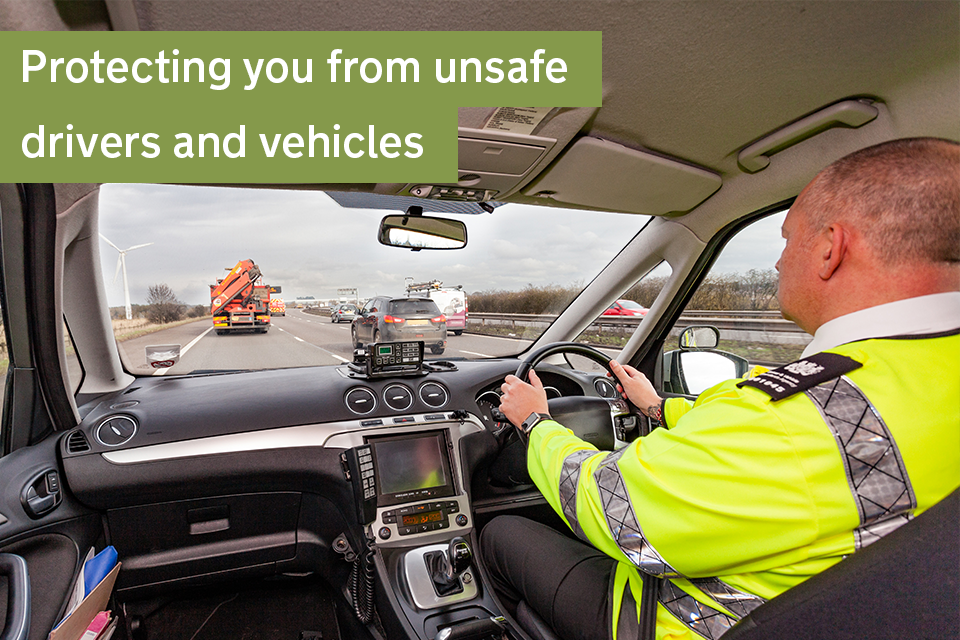
Protecting you from unsafe drivers and vehicles
Better information for drivers and operators
We’ll make sure:
- vehicles which have safety defects are fixed quickly by manufacturers to reduce the risk to the public
- it’s cheaper for companies to meet safety standards than to evade them
- companies who prove they have excellent safety standards will see lower costs and other commercial advantages
Raising standards for lorry, bus and coach companies
We’ll make sure:
- customers have clear information on safety recalls and on the record of manufacturers in repairing vehicles
- operators and lorry, bus and coach drivers can easily find and follow current rules
- lorry, bus and coach drivers and vehicle operators who don’t meet safety standards get help to improve
Enforcing the standards
We’ll make sure:
- companies understand the standards they must meet to apply for a vehicle operator licence, and those who can’t prove they meet the standards aren’t given a licence
- those who repeatedly or deliberately don’t meet the standards lose their right to operate or drive commercial vehicles in Great Britain
- vehicle manufacturers have clear guidance on how to recall vehicles to reduce the risk to drivers and all other road users
- vehicle operators know what to do, and what data to share, so they can ensure their own vehicles are safe to use
- we find and prosecute anyone who tries to cheat the systems that are in place to keep you safe - whether that’s anyone giving illegal driving instruction, cheating at the theory test, or fraudulently passing vehicles at an MOT
2.4 How DVSA will measure the success of the strategy
Our strategy will improve road safety, user experience and value for money.
The plans that we create for each of our 3 themes will set out how we’ll measure success in each area. This could include things like:
- the proportion of people killed or seriously injured being reduced
- more people passing their theory and driving test first time
- more vehicles getting their MOT before the current one expires
- more lorries, buses and coaches and trailers passing their annual test
- fewer vehicles on the road having serious defects
- more drivers following drivers’ hours rules
- recalled vehicles being fixed more quickly
- more driving test candidates having a test within 6 weeks of their preferred date
- more services provided on time and fewer tests cancelled
- less funding from the government
3. What the strategy depends on
At DVSA, there are 3 areas which are essential for the strategy to be successful:
- our people
- our infrastructure - including digital, data and technology infrastructure, and estates
- our relationships - including commercial relationships, and how we at DVSA communicate and work with others
By March 2018, we’ll create separate supporting strategies in these areas. They’ll support the work we need to do to make sure we’re successful in delivering our 5-year strategy.
3.1 People strategy
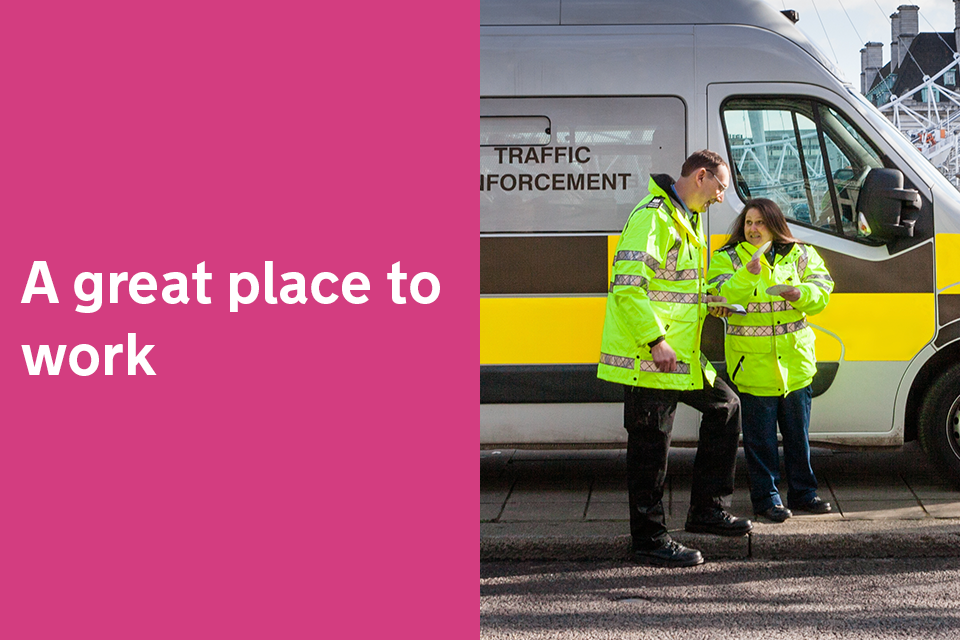
A great place to work
Our vision: a great place to work
Our people work in a positive culture and feel equipped and skilled to deliver the services customers require.
A talented workforce
We’ll make sure we:
- have a workforce of the right size and shape, with the right skills to provide our services now and in the future
- identify talented people and develop career paths to bring out the best in them
- promote growth of apprenticeships and work placements
High-quality leadership
We’ll develop leaders at DVSA who:
- inspire our people about our work
- are confident in our engagement
- empower our teams
An inclusive culture
We’ll make sure we:
- build a diverse, engaged and involved workforce where people feel valued, can raise concerns and suggest ideas to improve the way we work
- work in a way that enables our people to go home safe every day
- reinforce a positive culture where bullying, harassment and discrimination are not tolerated
Supporting our people
We’ll make sure we:
- help people maximise their contribution through focused learning and development
- develop and strengthen the skills of our managers
- introduce flexible, modern ways of working, supported by efficient IT, HR and finance processes
3.2 Infrastructure: estate strategy
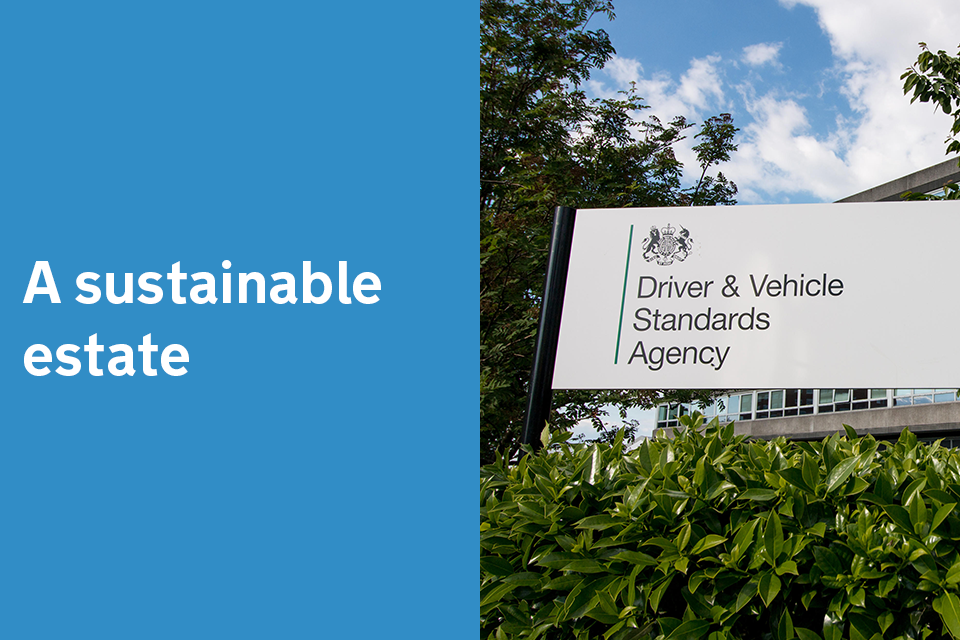
A sustainable estate
Our vision: a sustainable estate
Our estate is efficient, fit for purpose and sustainable, supporting service delivery and flexible to changing requirements.
The right size estate
We’ll make sure we:
- have the right numbers of sites
- make the best use of space, without compromising the service we provide
- respond to changing demands, such as changes to the way we provide services
- come up with innovative solutions to match changing service and technology requirements
Estate condition and location
We’ll make sure:
- our sites are safe and fit for purpose
- sites are in the right location for service users
- space is designed and maintained to a suitable and consistent standard
- our estate aligns with wider government policy
Sustainable estate
We’ll make sure:
- we prioritise ‘capital investment’ (funds we invest to further our objectives) to support our long-term goals
- multifunctional sites are functionally and economically viable and sustainable
- we continually improve the sustainability performance of the estate and facilities
3.3 Infrastructure: digital, data and technology strategy
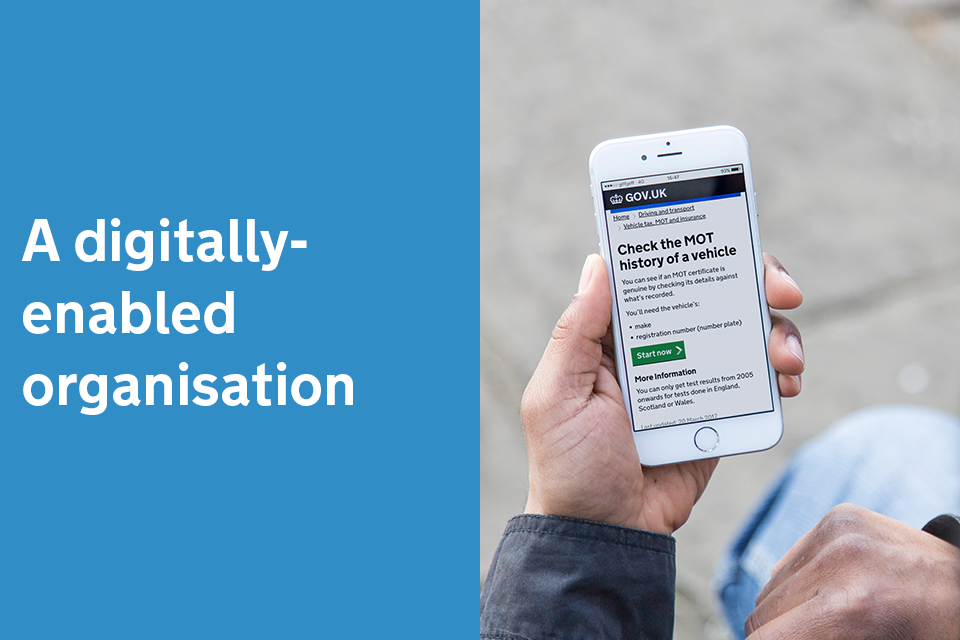
A digitally-enabled organisation
Our vision: a digitally-enabled organisation
Provide modern, efficient and sustainable technology to support a mobile workforce and build brilliant digital services for users
Making the most of digital
We will:
- invest in all user-facing digital platforms, to continuously improve user experience and increase efficiency and reduce costs
- take advantage of the efficiencies that digital practices provide
- support implementation of transformation programmes
- share data to make digital services simpler, quicker, and seamless to better meet users’ needs
Flexible working
We will:
- provide equipment that allows all staff to do their work efficiently
- only use mobile-friendly services and platforms to give our people and users better access
- provide reliable connectivity and remote access to applications wherever our people may be
Simplifying and working together
We will:
- simplify the way our staff work together
- provide technology solutions to help create a culture where we all work together and have better relationships with internal and external partners
- better understand the needs of our users, build closer partnerships, collaborate and share data on the delivery of projects and services
- make resources available to continually improve services
- reduce the complexity in our architecture and technical code so that software developers and designers can add new features more quickly
3.4 Relationships: commercial strategy
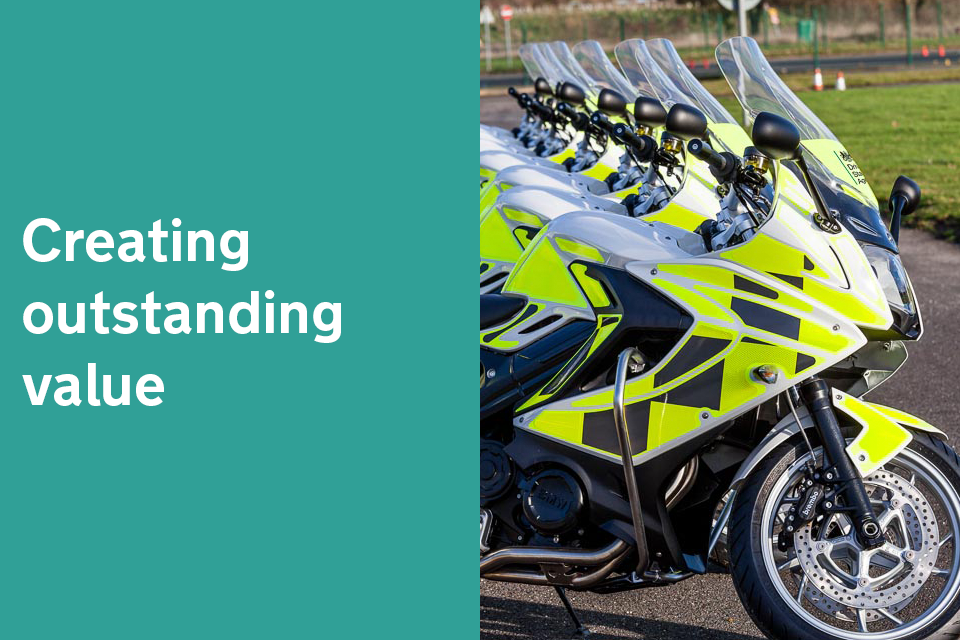
Creating outstanding value
Our vision: creating outstanding value
Everything we buy provides value for money.
A strategic approach
We will:
- create a full view of all contracts and commercial activity for a 3 to 4 year period using a ‘commercial pipeline’ - it’s a view of our current and planned procurements
- make sure we consider and test all commercial options early on
- create commercial business cases that go through the right governance processes
- improve our advanced commercial planning before contracts end or are procured again
Before we buy
We will:
- compete when the market is best placed to deliver - we’ll use early market engagement to design services accessible to as many suppliers as possible
- work with potential suppliers and across government to get the best value for money
- create flexible contracts that can adapt to our changing needs
- plan so we can make sure the right contract management support is available
When we buy
We will:
- follow agreed policy and regulation when we buy, and do it in a fair and transparent way
- involve senior managers throughout the procurement process
- make sure all our commercial activity has someone senior responsible for it, and that there’s an agency-wide understanding of commercial requirements
Managing what we buy
We will:
- regularly review contract management plans and follow contract management standards throughout the life of the contract
- create and maintain a strategic supplier relationship programme - this will make sure there’s continuity of service, high performance and effective risk management and delivery management
- collect and use data to support spend analysis, efficient contract management, minimise contract change and make decisions about future commercial activities
3.5 Relationships: communications strategy

Trusted communication, effective relationships
Our vision: trusted communication, effective relationships
Clear, trusted communication that changes behaviours and makes people safer - with relationships built on mutual understanding and respect.
Effective external communications
We will:
- use insight to create messages that change attitudes and behaviours
- run low-cost or no-cost campaigns
- go to where the audience is, including digital channels and social media
- create a more positive profile with the media, to help tell our story
Engaging internal communications
We will:
- use the right channel and content for the right internal audience
- make sure our intranet (DVSAnet) helps people to be more effective and connected at work
- use feedback and staff groups to support understanding and engagement
- make sure our leaders are great communicators who talk to and involve their people more
We know our users and stakeholders
We will:
- improve services by carrying out user research
- have named ‘account managers’ who will build better relationships with stakeholders
- be seen as a trusted and effective organisation by users and stakeholders
- be active in the groups and forums our users and stakeholders work in
Building communications capability
We will:
- help our staff to communicate better and build more effective relationships
- have more, and better trained, media spokespeople
- develop our communications and engagement staff so they’re confident and add even more value
4. Supporting road safety
Great Britain’s roads are among the safest in the world, but every death and accident on the roads causes devastation, distress or inconvenience. We want to stop them from happening.
This will reduce pressure on the NHS and emergency services, keep traffic moving and, as a result, keep our economy growing.
4.1 People killed or seriously injured on our roads
The number of road deaths has stayed about the same in recent years. We want to reduce them.
1,730 people killed on Great Britain’s roads in 2015
| Year | People killed on Great Britain’s roads |
|---|---|
| 2005 | 3,201 |
| 2006 | 3,172 |
| 2007 | 2,946 |
| 2008 | 2,538 |
| 2009 | 2,222 |
| 2010 | 1,850 |
| 2011 | 1,901 |
| 2012 | 1,754 |
| 2013 | 1,713 |
| 2014 | 1,775 |
| 2015 | 1,730 |
Source: Table RAS40001: Reported accidents, vehicles and casualties
In 2015, there were 22,144 seriously injured casualties and a total of 186,189 casualties of all severities in reported road traffic accidents.
4.2 Road transport is the main transport mode
Road transport is the main transport mode for individuals and businesses.
73% of people in Great Britain had a driving licence in 2014
Source: Road use statistics: 2016
89% of passenger miles are by road, and 73% of freight goods are moved by road.
Road freight contributes £11.2 billion to the UK economy, and the sector employs 222,000 people.
317 billion vehicle miles driven in Great Britain in 2015
Source: Transport Statistics Great Britain: 2016
There are 245,800 miles of roads in Great Britain, and a total of 317 billion vehicle miles were travelled on them in 2015.
4.3 Number of people learning to drive
Demographic data shows we should expect changes in the number of people taking theory tests and driving tests in the future.

Table showing UK population by age
Source: ONS Population Estimates for UK: mid-2015
The way we provide these tests needs to be flexible enough so we don’t have unused assets or an over-capacity in the services we provide.
4.4 Theory tests
Data shows that the pass rate for theory tests has been reducing in recent years.
| Year | Car theory test pass rate |
|---|---|
| 2007 to 2008 | 65.4% |
| 2008 to 2009 | 65.4% |
| 2009 to 2010 | 63.8% |
| 2010 to 2011 | 63.1% |
| 2011 to 2012 | 60.8% |
| 2012 to 2013 | 59.1% |
| 2013 to 2014 | 51.6% |
| 2014 to 2015 | 51.0% |
| 2015 to 2016 | 49.3% |
Source: Driving theory tests statistical data set
The noticeable decline in overall pass rates from 2013 to 2014 is attributed to the introduction of new questions and no longer publishing the actual questions used in the test.
4.5 Driving tests
The driving tests pass rate has been largely the same for some time, which keeps waiting times high. The overall pass rate for car driving tests in 2015 to 2016 was 47.0%. Improving the skills and experience candidates have before they take their driving test is essential.
1.5 million car driving tests carried out in 2015 to 2016
Source: Practical car test pass rates statistical data set
4.6 Preventing driving test fraud
We act against those who try to cheat these tests, either by impersonation, or using technology like hidden Bluetooth devices to get the right answers to theory test questions.
In 2015 to 2016, we acted on 818 reports of suspected impersonation, which related to 2,144 theory tests or driving tests.
355 people arrested by the police as a result of our investigations into driving test fraud in 2015 to 2016
We need to continue being able to stop people from cheating the system as technology and methods of fraud become more sophisticated.
4.7 Improving training provided by driving and motorcycle instructors
New drivers need to be trained by highly-skilled instructors to help them stay safe on our busy, modern roads.
39,878 approved driving instructors in Great Britain at March 2016
Source: Driver and rider testing and instructor statistics: July to September 2016
The national standard for driver and rider training sets out what you must know and understand to provide training to drivers and riders. The standard will need to change in response to changes in technology.
The standards check, which assesses an instructor’s ability to teach pupils, gives them a grade.
68.8% of approved driving instructors achieved grade B (sufficient) at their most recent standards check
Source: Driver and rider testing and instructor statistics: July to September 2016
We need to make sure that instructors have access to guidance and training to improve the service they provide.
We want to improve the arrangements for motorcycle instructors, to make sure that all instructors have to pass an assessment with DVSA.
We also want to introduce mandatory quality assurance checks for all motorcycle instructors - not just those who provide compulsory basic training (CBT).
4.8 Helping an ageing population drive safely
People are living longer, healthier lives. They rightly want to keep their mobility and independence as they get older.
| Gender | Life expectancy at birth in 1980 to 1982 | Life expectancy at birth in 2012 to 2014 |
|---|---|---|
| Female | 76.8 | 82.8 |
| Male | 70.8 | 79.1 |
Source: ONS National Life Tables, United Kingdom: 2012 to 2014
Age alone is not a reliable indicator of driving ability.
However, older drivers are more likely to die or sustain a severe injury than a younger adult in an accident of the same impact.
So we want to support older drivers and help them to stay safe.
4.9 Checking your vehicle is safe to drive
There are 35.6 million vehicles licensed for use on Great Britain’s roads. We have a vital role in making sure they’re safe to drive.
35.6 million vehicles licensed for use on Great Britain’s roads in 2015
Significant numbers of vehicles fail their initial MOT, which means they might not have been safe to drive when they arrived for their test.
36.8% of cars failed their MOT at the first attempt in 2015 to 2016
Source: MOT testing data for Great Britain
Vehicle defects were a contributory factor in 1,832 accidents in 2015.
We need to make sure that drivers understand the checks they should be doing all-year-round to make sure that their vehicle is safe to drive.
We can also do more with data to help drivers understand issues that are most likely to occur with their particular vehicle make and model.
4.10 Improving the quality of MOT tests
We’ve introduced an industry-recognised qualification for new MOT testers and managers.
We’ve also introduced annual training and assessments for the existing MOT testers. The training focusses on topics which our data shows testers are most likely to get wrong.
60,317 MOT testers in Great Britain at the end of March 2016
Source: MOT testing data for Great Britain
However, the quality of testing isn’t consistent for every MOT centre and tester, which leads to warnings and disqualifications.
451 MOT testers warned or disqualified in 2015 to 2016
Source: MOT testing data for Great Britain
We’ll continue to increase our focus on serious fraud, dishonesty or negligence in the MOT system, so we’re sure vehicles that pass the MOT are safe to drive.
4.11 Large vehicle tests
The annual test for lorries, buses and trailers is similar to the MOT test that cars take each year.
These used to be carried out at government testing stations. Since 2010, a network of over 530 privately-owned testing facilities has been set up.
In 2015 to 2016, our assessors carried out 95% of 733,312 annual tests at these ‘authorised testing facilities’ (ATFs). The remainder were carried out at DVSA sites.
733,312 annual tests for lorries, buses, coaches and trailers carried out in 2015 to 2016
15.3% of vehicles failed their annual test at the first attempt in 2015 to 2016
| Year | Number of ATFs | Number of DVSA annual test sites |
|---|---|---|
| 2013 to 2014 | 432 | 55 |
| 2014 to 2015 | 483 | 38 |
| 2015 to 2016 | 539 | 38 |
Source: Commercial vehicle testing data for Great Britain
By carrying out annual tests from ATFs, vehicles don’t need to travel to and from DVSA sites. This lets businesses use their vehicles more efficiently.
Reducing these unnecessary journeys cuts emissions and causes less wear and tear on roads and vehicles.
95% of annual tests carried out at an ATF in 2015 to 2016
Source: Commercial vehicle testing data for Great Britain
We’ve been improving the service we provide to ATFs, by making our vehicle standards assessors available 24 hours a day, 7 days a week, subject to demand from businesses.
Allowing operators to test their own vehicles
We want to look at the benefits and risks of allowing commercial vehicle operators with excellent safety standards to test their own vehicles. Any change here will require new legislation, and will only be considered if road safety can be protected.
This would help them to keep their fleets moving effectively,
4.12 Roadside checks
We stop lorries, buses and coaches to carry out checks at the roadside. We can issue a prohibition if necessary, which prevents you from driving until you get a problem with your vehicle fixed.
35.6% of mechanical checks at the roadside and operators’ premises led to a prohibition in 2015 to 2016
Source: Vehicle enforcement data for Great Britain
We can also issue fixed penalties if you commit certain offences. Some of these are graduated depending on the circumstances and seriousness of the offence.
£4,380,250 in fixed penalties issued in 2015 to 2016
Source: Vehicle enforcement data for Great Britain
We use the Operator Compliance Risk Score (OCRS) system to help us decide which vehicles should be inspected. It assesses the risk of an operator not following the rules on the condition of its vehicles and other factors, such as drivers’ hours and weighing checks.
Data shows that vehicle operators based outside of Great Britain are comparatively less compliant than operators based in Great Britain. Fines are not a deterrent at current levels and will be reviewed.
We want to focus our resources on those vehicles operators who are regularly and seriously non-compliant and allow those operators with consistently high standards to operate more freely.
However, if we encounter an unsafe vehicle from an operator with a previously good performance record, we’ll still intervene to protect the public.
4.13 Recalling unsafe vehicles and stopping defects
The number of vehicles being recalled for safety defects is increasing. There were 1.2 million vehicles, parts or accessories affected in 2014 to 2015, which increased to 2.7 million in 2015 to 2016.
2.7 million vehicles, parts or accessories affected by a safety recall in 2015 to 2016
Source: Vehicle safety defect investigations, recalls and collision investigations data for Great Britain
Recalling vehicles quickly to get them repaired is vital for safety and public confidence.
We’ll do more work with manufacturers to reduce the number of defects, and make sure common problems are shared rapidly between manufacturers to protect all road users.
4.14 Preparing for new vehicle technology
Automated vehicle technology will change the way we travel. It also has the potential to make road transport safer.
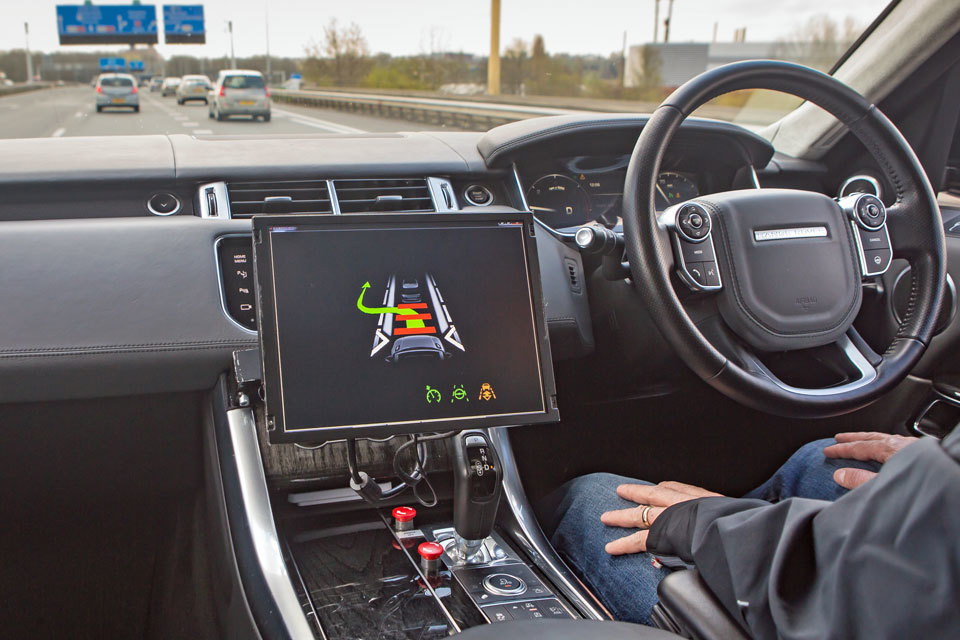
Within the next 4 years, vehicles that can pilot themselves on motorways with human oversight will be available
We’re moving towards driverless cars, where fully automated vehicles will transport people and goods to their destination, without any need for a driver. But it’ll be a while before a fully driverless car can carry out a door-to-door journey.
However, within the next 4 years, vehicles that you can park with line-of-sight remote control, or that can pilot themselves on motorways with human oversight, will be available.
Our strategy will help us to make sure that drivers have the skills, knowledge and understanding to use these new technologies safely.
Making sure vehicle tests stay up to date
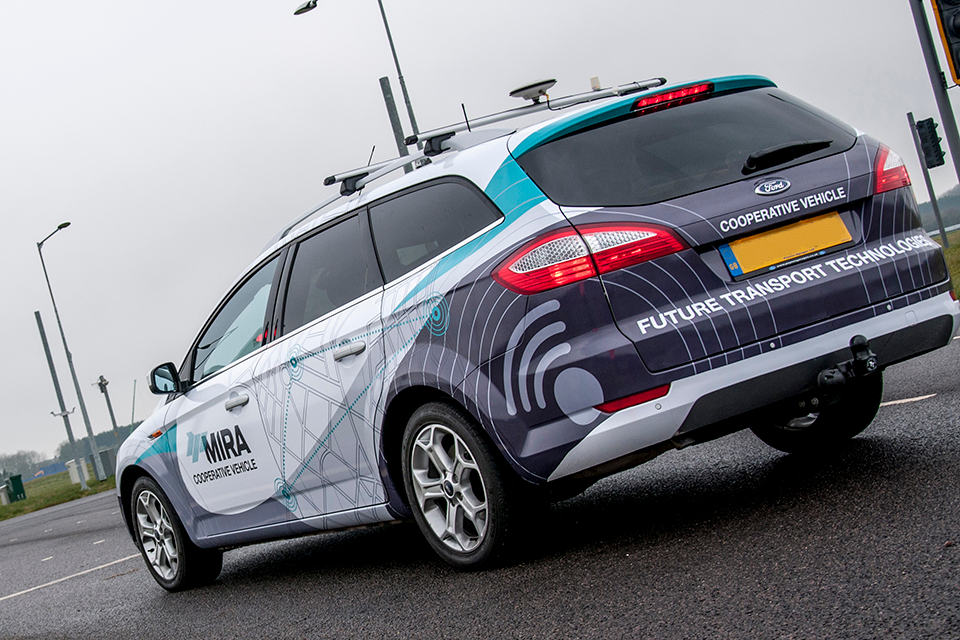
Driverless car
Driverless cars have cameras, sensors and software that:
- ‘read’ traffic signs and traffic lights
- detect other vehicles, cyclists, pedestrians, and hazards.
In some cases, the sensors use lasers to measure the distance to objects. These are used to build up a 3D map of the area.
Driverless cars also receive geolocation information from GPS satellites and have other instruments to help measure the car’s position.
These all help to give the car the data it needs to work safely.
We need to make sure that vehicle tests adapt over time to check that these sensors and instruments work correctly, and that vehicles have the latest software updates.
We also need to prepare for vehicles being able to self-diagnose more types of problems and report them to the driver.
5. Supporting our aims and ambitions
At DVSA, our strategy brings together work we’re already doing, and work we need to do in the future, to help you stay safe on Britain’s roads.
It also addresses:
- what our people say they understand about our purpose and objectives
- our aims for how we work
- how we want to manage our finances
- the expectations of people who use our services
5.1 Our people
We employ around 4,600 people across Great Britain. They include:
- driving examiners
- vehicle standards assessors
- traffic examiners
- vehicle examiners
- customer service agents
- registration and licensing officers
- digital services and technology experts
- corporate services, such as communications, finance and HR
4,600 people carrying out safety-critical public services
5.2 Our aims for how we work
Our ambitions are that we:
- put the people who use our services at the heart of what we do
- focus regulation and improve competitiveness for businesses
- improve our efficiency and effectiveness
- become a technology-enabled organisation
- are respected by our people and stakeholders
In everything we do, we value:
- professional expertise
- being respectful
- working as one team
- continuous improvement
- operating in the community
- achieving results
- good service for users
Our strategy takes account of these ambitions.
5.3 Our finances
We’re a government trading fund. This means most of our income comes from the fees people pay for our services - for example, paying for a driving test.
However, DfT funds some of our enforcement work through the ‘single enforcement budget’. This funding is more than the money we collect through fixed penalties we issue at the roadside.
We want to move to a situation where we can fully recover the costs of our enforcement work from the fixed penalties we issue. This would help us become self-funding.
Any surplus we make will be reinvested in new and improved services for customers.
Future savings
We have an ambitious plan of activities which will create savings of £51 million.
£51 millionof savings will be made by 2020
The savings will come from activities such as:
- rolling out more flexible vehicle testing services
- piloting alternative methods for vehicle testing and enforcement
- the contract for providing the theory test service
- making our central operations estate more efficient
- selling goods vehicle testing stations we no longer need
- approving more ATFs
- reviewing driver examiner training
- developing the ‘earned recognition’ concept
- remote enforcement
5.4 Understanding the needs and expectations of users
To design services that are easy to use and valued by the people who need them, we need to understand their circumstances, influences and expectations.
User research will help us understand what we need to do to design a good user experience.
Learning to drive
User research helps us understand how people feel about learning to drive and driving tests.
I started looking for a driving instructor but you can’t really tell who’s a good instructor.
Online driving tests, showing visually how to approach traffic lights etc with incidents happening on the way, such as having to pull in quickly.
I have a changing schedule at work, so really it would depend on my schedule for a particular week, when I would like the test.
I went to book my test in October as I was ready and the earliest booking was December, so I had to wait and keep paying for lessons to keep practising.
Mock tests with the examiner would break the ice.
Business
User research helps us understand how people feel about running transport businesses.
I don’t wish to merely comply with the minimum standards, but take pride in excellence and professionalism.
Information about new legislation or practices is vital as it is often the only way that a very small business operator can obtain up to date information to ensure compliance.
Business is hard. Any help to feel good in what we are doing is welcome.
There can be a ‘partnership’ with DVSA and the operator, repairer, tester and technician.
I panic quite a lot about sticking to the regulations.
6. Supporting government policy

Houses of Parliament
6.1 British road safety statement
The government has a commitment to reduce the number of cyclists and other road users killed or injured on our roads every year.
The government’s road safety statement sets out the approach to improving road safety. It includes actions on issues such as:
- safer road users
- safer vehicles
- road safety management
At DVSA, our 3 strategic themes directly support these issues.
6.2 Motoring services strategy
The government’s motoring services strategy sets out the goal of making DVSA more responsive, more flexible, with services delivered in ways that better meet users’ needs.
As part of that strategy, we’ve committed to things such as:
- looking at the case having more of our services (for example, large vehicle testing) provided by partner organisations
- working with DVLA to streamline the large goods vehicle driver licensing process
- improving our relationship with driving instructors, working towards publishing more information about them to improve the choice for learner drivers
Our strategy takes account of these commitments.
6.3 Spending Review 2015
The Spending Review gave a view of the government’s spending plans from 2016 to 2020. It looks at the budgets of all the government departments.
They’re divided into:
- resource spending - which covers the cost of policies, programmes and administration
- capital spend on assets like buildings and roads
As an executive agency of DfT, we’re expected to deliver both a dividend and capital receipts from the sale of assets.
Our strategy includes measures to help us become more efficient and to put us on a self-funding basis.
6.4 The UK’s exit from the EU
The government has made it very clear that the UK will leave the EU. Making sure that new arrangements work and are effective is a top priority for the government.
When we leave, existing EU law will be converted into UK law. Parliament (and, where appropriate, the devolved administrations) will then be able to decide which parts of that law to keep, amend or repeal.
DVSA is likely to have an important role in helping to introduce new systems and processes that will need to be in place.
So we’ll work closely with the rest of government to make sure that the functions and processes for driving and vehicle tests, enforcement and market access work efficiently after we leave the EU.
Our strategy allows us to be flexible to respond to any necessary policy or operational work that we need to do for new systems and legislation.
6.5 DfT’s single departmental plan
Our strategy supports DfT’s single departmental plan, which describes DfT’s objectives for 2015 to 2020.
6.6 Government transformation strategy
Our strategy supports the government transformation strategy, which sets out how the government will use digital to transform the relationship between the citizen and state.
-
Video transcript:
We’re the Driver and Vehicle Standards Agency - or DVSA.
As part of the Department for Transport, we’re helping you stay safe on Britain’s roads.
We do this in 3 ways.
1.Helping you through a lifetime of safe driving.
We’ll make sure you have the information you need to learn to drive, such as how to choose the best instructor.
New drivers need to be trained by highly-skilled instructors, so we’ll continue improving the standards for driving instructors.
Theory tests and driving tests will keep up to date with vehicle and technology changes, to make sure you learn the skills you need to drive safely.
We’ll make it more convenient to take your tests at a time and place that suits you.
And we’ll work with other organisations to make it easy for you to keep your knowledge and skills up to date for the rest of your driving life.
2.Helping you keep your vehicle safe to drive.
We’ll make sure you know what checks to do throughout the year to be sure your vehicle is safe.
When it’s time for your MOT, we’ll make it easier for you to get it done on time - and know where you can get it tested.
Testing will keep up with changes in vehicle technology, so all types of vehicle tests will check the right things at the right time to keep your vehicle safe.
We’ll continue to professionalise the MOT industry, so you’re confident that your vehicle is being tested by a qualified expert to the right standard.
We’ll open up our data about vehicle testing, so that it’s easier to make decisions about the next vehicle you buy and how to keep your vehicle safe between MOTs.
We’ll investigate whether commercial vehicle operators with excellent safety standards should be given permission to test their own vehicles, so they can keep their fleets moving effectively.
3.Protecting you from unsafe drivers and vehicles.
We’ll investigate the consequences of unsafe drivers and vehicles, and we’ll do more to stop them from causing accidents in the first place.
We’ll work with vehicle manufacturers to prevent vehicle safety defects, but we’ll continue to make sure any vehicles with safety defects are recalled and fixed quickly.
We’ll encourage commercial vehicle operators to share their data with us so we can leave the best operators to go about their business. We’ll target our inspections and roadside checks at those most likely to be a danger to your safety.
We’ll stop operators and drivers who deliberately put you at risk from using our roads.
Working with our partners, we’ll find and prosecute anyone who tries to cheat the systems that are in place to keep you safe - whether that’s people giving illegal driving instruction, cheating at the theory test, or fraudulently passing vehicles at an MOT.
We have a clear vision for the future.
Safer drivers.
Safer vehicles.
Safer journeys for all. ↩
